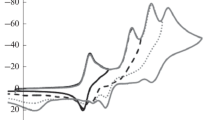Abstract
In the electrochemical reduction of 2,6-bis- and 2,4,6-tris(nitrophenyl) derivatives of 3,5-dicarbethoxy-1,4-dihydropyridine, in the first stage, one of the para-nitrophenyl groups in position 2 or 6 of the heterocycle is reduced. Free radicals have been obtained and identified, the primary species being ion radicals of the nitrophenyl type. The presence of the heterocycle in the molecule of the 1,4-dihydropyridine derivative stabilizes secondary free radicals of the nitrosophenyl type. In the process of electrochemical reduction, no evidence has been found of any intramolecular transfer of electrons or protons from the dihydropyridine part of the molecule to the nitrophenyl groups. Derivatives of 2,6-bis(p-nitrophenyl)-3,5-dicarbethoxy-1,4-dihydropyridine have been synthesized, and the oxidation and methylation of these derivatives have been studied.
Similar content being viewed by others
Literature Cited
L. Kh. Baumane, Ya. P. Stradyn', R. A. Gavar, A. P. Gaukhman, and G. Ya. Dubur, Khim. Geterotsikl. Soedin., No. 11, 1494 (1988).
Ya. P. Stradyn', I. Fol'ke, L. Kh. Baumane, V. Vol'kova, I. Klima, G. Ya. Dubur, and R. A. Gavar, “Electrochemical reduction of 4-(nitroaryl)dihydropyridines; cyclic voltammetry and ESR spectra of electrochemically generated anion radicals,” Preprint, IOS Akad. Nauk Latvian SSR (1985).
L. Baumane, J. Stradins, R. Gavars, and G. Dubur, Electrochim. Acta (in press).
J. E. Wertz and J. R. Bolton, Electron Spin Resonance, McGraw-Hill, New York (1972).
J. Stradins, J. Ogle, V. Kadysh, L. Baumane, R. Gavars, and G. Dubur, J. Electroanal. Chem., 226, 103 (1987).
R. A. Dommise and F. C. Alderveireldt, Bull. Soc. Chim. Belges, 82, 441 (1973).
B. S. Chekavichus, A. é. Sausin', R. M. Zolotoyabko, and G. Ya. Dubur, Izv. Akad. Nauk LatvSSR, Ser. Khim., No. 1, 77 (1985).
J. L. Kwiz, R. Hutton, and F. H. Westheimer, J. Am. Chem. Soc., 83, 584 (1961).
Yu. M. Kargin, V. V. Kondranina, and N. I. Semakhina, Izv. Akad. Nauk SSSR, Ser. Khim., No. 2, 178 (1971).
Ya. P. Stradyn', R. A. Gavar, and L. Kh. Baumane, Izv. Akad. Nauk SSSR LatvSSR, No. 2, 73 (1986).
Author information
Authors and Affiliations
Additional information
Translated from Khimiya Geterotsiklicheskikh Soedinenii, No. 4, pp. 481–487, April, 1991.
Rights and permissions
About this article
Cite this article
Baumane, L.K., Stradyn', Y.P., Gavar, R.A. et al. Free radicals in electrochemical reduction of 3,5-dicarbethoxy-1,4-dihydropyridines with nitrophenyl groups in positions 2, 4, and 6. Chem Heterocycl Compd 27, 380–386 (1991). https://doi.org/10.1007/BF00480834
Received:
Revised:
Issue Date:
DOI: https://doi.org/10.1007/BF00480834



